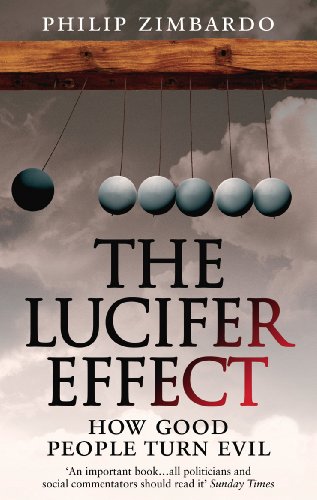“The line between good and evil is permeable and almost anyone can be induced to cross it when pressured by situational forces.”
Phillip Zimbardo
What lures good people to the dark side? The disturbing metamorphoses that make seemingly good, well-educated people commit heinous acts. Is it the temptations to act immorally? Or the feel-good moment of gaining control? How is it that moral people are seduced to cross the line between good and evil?
These are people who have no traumatic past or disorders and yet they find themselves at the mercy of a particular situation. A situation that yields enough influence to help them cross the line and render these people defenceless. In the end, these seemingly moral and good people find themselves dehumanized. This dehumanization is serious enough to help them commit atrocious acts against another individual or group.
To think if someone is incapable of being seduced to the immoral side is wrong. In his famous Stanford Prison Experiment, renowned social psychologist Phillip Zimbardo demonstrated that every man and woman, regardless of the social constructs placed upon them, are capable of being turned into monsters.
When situational forces and group dynamics work hand in hand, the results are often heart-wrenching. This transformation can be seen throughout history. Perhaps the most widely known example is the Salem Witch Trials. When collective hysteria and religious fanaticism held humanity in its grip and 25 people were executed.
To Zimbardo, the notion of “bad apples” is replaced by the notion of “bad barrels”. As he noted, it is not the individual that contaminates the social setting and system, but rather the other way round. Perhaps this is why Zimbardo also pointed out that the line that most people seem to draw between good and evil is penetrable. While most people are convinced that they are on the good and moral side and can resist the lures of evil, it is not set in stone. To people who think that evil stands on the other side of the line which they would never cross, Zimbardo makes it known that every human being is capable of crossing the line.
In popular fiction, the audience is often attracted to the anti-hero. Lacking the conventional heroic qualities makes them almost too real. After all, not everyone walks around with their ethics upheld all the time. What makes anti-heroes more popular is that they act as a sublimation. Often, people find themselves in a situation where they have to grit their teeth and follow-through, but the anti-hero steps up, even put their morals aside, so the audience doesn’t have to.
But what about the seemingly innocent character who is pushed to the point of no return? Popular fiction is filled with these characters. Yet they are as loved as ever, even after their atrocious acts.
Let us take a look at what is the lucifer effect, what made these loveable characters cross the line of good and evil, and if this permeable line can be drawn thicker.
What is Lucifer Effect?
The beginning of the Lucifer’s Effect was Zimbardo’s Stanford Prison Experiment in 1971. But the society witnessed its full blow in 2004. When a Television Programme “60 minutes” broadcasted images that America was not prepared to see and perhaps could never have been. These images came out of the Abu Ghraib prison in Iraq.
The images showed American soldiers – men and women – sodomize and torture Iraqi prisoners in the most brutal and dehumanizing ways. These images came out of the digital cameras of these soldiers that called them “Trophy Photos”.
This only strengthened the results found in Zimbardo’s Stanford Prison Experiment. To demonstrated the power and influence of labelling, group identity, rules, symbols, and situational validation, Zimbardo began his experiment in August 1971. The experiment was supposed to go on for two weeks.
Randomly dividing a group of undergraduate students (selected randomly) into two equally numbered groups. Zimbardo labelled one as “prisoners” and the others as “guards”.
“Arrested” by actual police, the “prisoners” were handed over to the “guards” in a mock prison. For creating an “atmosphere of oppression”, the “prisoners” were “dressed” in uniforms.
On the second day itself, the “prisoners” staged a rebellion and the “guards” worked out a system of reward and punishment to keep them in check. In days to come, Zimbardo witnessed an unimaginable level of cruelty and acrosticism from the Liberal university students. The “guards” otherwise known for their altruism and kindness had crossed the line of evil. On day six, the “guards” were out of control. It became so extreme that Zimbardo had to conclude his experiment in less than a week.
What made these students cross the line between good and evil? Role-playing.
It is not to say that their actions were justified or that in years to come the atrocities of the guards in the Abu Gharib prison were the victims. Rather, it was Zimbardo’s way of holding a mirror to mankind. The belief that moral people are untouched by evil suddenly shattered.
Any and every human being is capable of going over to the “dark side”. Even those who remain silent as they watch evil acts being committed against another individual or group are “evil of inaction”. Understanding this social phenomenon is not an excuse for such actions. As Alexandr Solzhenitsyn, the Russian poet stated, “The line between good and evil lies at the centre of every human heart.”
Human behaviour is a complex phenomenon. Behind every human behaviour a more complex system of psychological processes works to bring the behaviour to the forefront. While social psychologists try to decipher these psychological processes, authors and storytellers weave them into their characters to bring life-like characters to pages and the audiences’ screens.
Most simply understood, Lucifer’s Effect is a point in time when a seemingly harmless, moral, and innocent individual or group decides and finally crosses the line between good and evil and commits immoral acts. These individuals in no way have previous cases of trauma or any disorders.
What makes up the Lucifer Effect?
After his Stanford Prison Experiment, Phillip Zimbardo identified four psychological processes that essentially make up the Lucifer’s Effect. These four psychological processes are:
• Obedience of authority: To put it simply, obedience refers to the social influence under which an individual chooses to act in response to a direct order by an authority figure. It is important to note that the acts the individual commits would not have otherwise occurred if not asked by an authority figure. It involves a hierarchy of status or power. Individuals commit such acts by justifying that these were orders by someone of higher ranking and would not have happened otherwise.
• Group Conformity: Another type of social influence, though it stands apart from obedience. When an individual changes their belief or behaviour to fit in with a group, it refers to conformity. The pressure to conform can be real, that is, the individual could be forced, or imagined, that is, it could be due to social pressure or norms. Everyone in their daily lives takes part in group conformity in some way or other. Though, there are always outliners that indulge in non-conformity. This behaviour change can be temporary or permanent, depending on the type of conformity.
• Moral disengagement: Simply put, when an individual convinces himself/herself that ethical standards do not apply to him/her in a particular situation or context, he/she is engaging in moral disengagement. This phenomenon was given by renowned social psychologist Albert Bandura. This phenomenon is further broken into four categories: Moral Justification (doing something evil for the greater good), Diffusion of Responsibility (blaming their acts on someone else, usually an authority figure), Mispresenting Injurious Consequences (Minimizing the consequences of their actions), and Dehumanizing the Victim (victims are blamed to have bought the acts onto themselves).
• Environmental factors: Temperature, food, pollutants, population density, sound, light, and parasites are all environmental factors that can affect how an individual behaves. Environmental factors can and most definitely do affect how an individual behaves. Extreme environmental factors can cause a great level of stress in an otherwise healthy individual. Individuals are more likely to engage in evil acts when the environment around them is less than favourable.
According to Zimbardo, these psychological processes had the power to transform the actions of any and every individual. He presented a scientific explanation about the circumstances that aid the metamorphoses of an individual, from uncorrupted to corrupt.
In Popular Fiction
Cast out of heaven, the fallen angel Lucifer is perhaps the best-known personification of evil and the nemesis of everything good. Once a glorified angel, Lucifer defied God, which became the reason for his fall. It’s easy to see why Zimbardo called it the Lucifer’s Effect.
Popular fiction is filled with characters that crossed the line of good and evil, most to the point of no return. Here is a look at six of the most well-known characters in popular fiction that were ultimately lured to the dark side:
• Peter Pettigrew from the Harry Potter Series: As an extreme survivalist, Peter Pettigrew was already a character susceptible to the Lucifer’s Effect. To add to it, he had no confidence in himself since his early days, and he most definitely had no interest in gaining some. Neither did he see a need to do so. Peter Pettigrew enjoyed keeping the company of friends who were bigger and stronger. People who could look out for him. That was primarily the reason he joined the friend circle of James Potter, Sirius Black, and Remus Lupin. While James Potter and Sirius Black were “the biggest bullies” so to say on the grounds of Hogwarts, Remus Lupin had the brains. To Peter, they were the best “ship” to stay on during his Hogwarts career. While he would never pick on anyone, especially Severus Snape alone, with company he was more than willing.
When the war broke out and the Marauders along with the Order were willing to fight for what they believed was right and the protection of their loved ones, Peter had to choose. As Voldemort and his fellow Death Eaters bought the Ministry to their knees, Peter saw his “ship” sinking and as an extreme survivalist, he chose to jump “ships”. He might have loved his friends but he loved himself more. With that came his betrayal against not only James Potter and his family but also Sirius Black and the Order as a whole. Peter willingly made the same choice time in and again, until his ultimate demise.
• Theon Greyjoy from A Song of Ice and Fire Series: At the age of no more than ten, Theon Greyjoy was taken as a hostage (“ward”) to Winterfell by Eddard Stark at the order of Robert Baratheon. While he was treated well, trained, and fed, even befriends Eddard and Catelyn Stark’s eldest son Robb Stark and Jon Snow, Theon knows the cold reality. He was a hostage and if his father did something that wasn’t approved by the Starks or the Baratheons, he would lose his head.
Years after his return to his home Iron Islands, Theon never imagined that not only would he not be received with honour but his father would gamble with his life the way he does. The promise he made to Robb Stark to make his father promise an alliance to the Starks fell through as soon as he realised, he had no real choice. Set in the Feudal times, the only “right choice” Theon ever had was to choose his blood family, no matter how close he was to Robb Stark. Even if he had called out his father, Balon Greyjoy, for Starks taking him away, he would not have survived to tell the tale to Robb. He was vilified for becoming “one of them” (the Starks) when he always considered himself a Kraken.
Conflicted with staying loyal to Robb and making his father happy, Theon chooses the latter. But the only decision he makes out of his agency is taking over Winterfell that is the undoing of Robb Stark and the entire Stark family. Of course, Theon is paid back for his deeds by Ramsay Bolton. It is only then that he realises his real father died on the steps of Baelor.
• Michael Corleone from The Godfather: Perhaps the smartest of the four children of Vito Corleone, his father’s favourite, Michael had no interest in taking on the family business let alone reach a place no one could touch him. Even when he killed Sollozzo and McCluskey, he only does it to save his father’s life. To Michael, he had to get to Sollozzo and if he had to kill McCluskey in the way, it was collateral damage. A necessary evil.
What changed him was that during his happiest times when he was in Sicily with the love of his life Apollonia, Sonny was murdered. As he decides to leave his villa because it was no longer safe for Apollonia and him, his bodyguard Fabrizio, now with Barzini, fits a bomb in his car, that instead of killing Michael kills Apollonia, their unborn child, and his loyal bodyguard Calo. From that point on, his life only goes downhill. His other brother, Fredo, plots with Johnny Ola, Roth’s man. His wife, Kay, essentially a replacement of Apollonia, kills Michael’s child because she believes he is evil. His father passes away before Michael was ready to take over the family business. Tessio, Vito’s oldest friend was convinced by Barzini to betray Michael.
Even as Michael realised, he was turning evil, he had no way to stop it. He does not want to get hurt anymore. Everywhere he turned all he saw betrayal and his world got smaller and smaller until he was in a place where no one could touch him.
• Dorian Grey from The Picture of Dorian Grey: Dorian Grey sold his soul to the devil for youth and wanting more than what life has to offer. His struggle to pick the side between good and evil was a struggle of everyman. When Basil painted his portrait, Dorian wished his portrait to age in his place when Lord Henry poisons his mind with a hedonistic way of life.
The first act of evil committed by Dorian was how he broke Sybil’s heart as he was further poisoned by Lord Henry. Though he was guilty of it when Sybil takes her life, Lord Henry hands him a yellow book about the hedonistic lifestyle, that Dorian engages in for the next 18 years. As Dorian remains youthful as ever, his portrait ages into something unrecognizable, a mirror of his corrupted soul. Concerned for Dorian, Basil tries to make him repent but instead is shocked and scared when Dorian shows him the portrait. In a fit of rage, Dorian murders Basil.
Blackmailing his friend, a doctor, Dorian disposes of Basil’s body. When Dorian enters the opium den after the murder, Sybil’s brother, James recognizes him and seeks to avenge his sister. Though Dorian escapes. Eventually, he is ladened with guilt and fear, but that resolves when a hunting party accidentally kills James Vane.
Eventually, Dorian realises he needs to turn the leaf. His redemption comes in form of him destroying the portrait. A loud cry is heard from the attic where he has locked his portraits that restores to its old form while Dorian withers to the point his servants only recognize him from the ring on his hand.
• Jean Grey from the X-Men Series: Starting from a level-headed character and the weakest X-Men, Jean Grey had trouble controlling her telepathic abilities. After sacrificing herself to save the X-Men, the Phoenix Force merges with her and raises her to the level of strongest human character in the Marvel universe.
Under the influence of the Dark Phoenix, Jean Grey became the ultimate killing machine. Mass murdering a billion inhabitants of a nearby planet was the worst of Jean Grey or the Dark Phoenix within her.
Although her redemption came in form of showing Jean Grey a separate entity from the Dark Phoenix.
• Thomas Shelby from The Peaky Blinders: As a recently returned soldier from World War I, Thomas “Tommy” Shelby had already seen things that had changed him.Suffering from PTSD, his life is dominated by an attempt at moving his family up in the world.
While his pre-war personality is explored in-depth much later in the series, it becomes instantly obvious the two could not be more in contrast. Tommy’s post-war personality is essentially the embodiment of evil. Not only does he openly indulge in violence, but he is also selfish, calculative, manipulative, cunning, and ruthless. Though all of the choices are made to protect his family and their well-being, they are his choices nonetheless. Tommy is the epitome of abused becoming the abusers.
Takeaway: To prevent or to Ignore?
According to Zimbardo, everyone carries a “seed” within themselves. Situational factors, social context, and psychological pressure can water this “seed” of evil in us. Extraordinary conditions can push the seemingly ordinary individuals to go from one end of the continuum to another.
However, when the time comes to act and the power to choose between doing right by oneself and by others versus the wrong resides in one’s hands, it is up to the individual to make the right decision. To go in the other direction when everything about the “dark side” is alluring. This choice presents itself every day, and an individual must fight every day to not succumb to evil.
The choice to betray his childhood best friend, James Potter, and his family became Peter Pettigrew’s undoing. To submit to Lord Henry’s hedonistic way of life was Dorian Grey’s choice. Theon Greyjoy’s betrayal to the Robb Stark came back in form of Ramsay Bolton. Michael Corleone lost the battle to what he believed was wrong. Despite gaining wins, Thomas Shelby still had to lose more. And while limitless power may be an ultimate dream, Jean Grey loses herself in the process.
Every choice, where the characters could’ve turned around, they chose not to. As the choices began piling up, they set their outcome themselves. While most of these characters and many other in popular fiction redeem themselves, it goes on to show another side of the Lucifer’s Effect.
If one side of the coin is the moral entering the world of the immoral, the flip side is a reality too. Not all people turn evil. The world at large and popular fiction is filled with people who resist. If ordinary people can be changed by extraordinary circumstances to do something immoral, these ordinary people can also move to do something extraordinarily heroic.
The world is filled with such ordinary individuals committing heroic deeds. Simply because they chose to. Zimbardo himself envisioned a “Reverse Milgram” experiment. To him, if people could behave immorally when forced by situational factors and psychological pressure, they could also be complied to perform good deeds. “To right a wrong” is worthy of being considered “heroic”.
The choice to not forget who we are lies within ourselves.
Author’s Bio: Disha Walia is a writer, editor for those who have trouble putting thoughts into words, and a lifelong storyteller. As a Psychology graduate with a Master’s degree in English, she loves exploring the unknown world of words with an interdisciplinary approach. She has a love for hobbies that focus on finer details, creativity, and intriguing depths.
By Disha Walia











